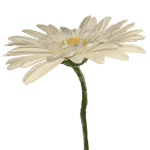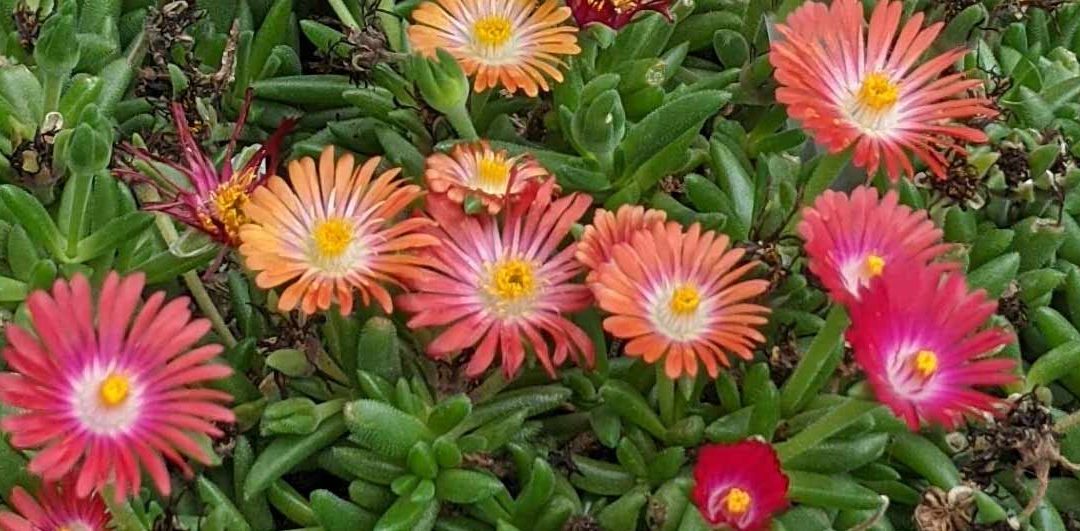Perhaps you would like to know what these brightly colored flowering plants are when you visit the South West Coast of England or the Botanic Garden in Ventnor/ IOW in the UK.
They are called ice plants because their stems and leaves are covered with small cells that have water-retaining tissue that resemble ice cristals. This causes them to glisten in the sunshine, appearing to be covered with ice.
They all have daisy like flowers and are all members of the ice plant family Aizoaceae, but differ considerably regarding their flower color spectrum, their leaves structures , hardyness, lifespan and invasiveness.
I have selected a few members of the ice plant family that I encountered on the South Coast of England / IOW, UK.
- Carpobrotus edulis, (hottentot fig, pig face, flowers usually in yellow color) native to South Africa, and is classed now as invasive in Cornwall. It is not permitted to plant them in wildlife areas in Dorset/ England
- Delosperma cooperi, Cooper’s ice plant – non- invasive
- Lampranthus spectabilis , (trailing ice plant) – non – invasive
- Mesembryanthemum spp. ice plant – non- invasive (picture just added).
What are the differences between Carpobrotus edulis, Lampranthus spp., Delosperma spp. and Mesembryanthemum spp.?
The lifespan of the various genera varies depends on growing conditions and care and on average Lampranthus spectabilis is therefore expected to last for about 10 years, Delosperma spp. will grow for about 40 years and Carpobrotus edulis will endure for about 50 years, you guessed it that it is very invasive and almost indestructible.
My favourite ice plant is Lampranthus ‘Tresco Magenta’. Lampranthus spp. are native to South Africa. ‘Tresco Magenta’ grows on the South coast of the IOW in and outside the Ventnor Botanical Gardens and in Ventnor town in masses and in the South West / Cornwall. This cultivar was named after Tresco Abbey Gardens, Tresco, Cornwall, Scilly Islands, UK, west off Cornwall. Other cultivars are ‘Tresco Fire’, ‘Tresco Red’.
The hardyness also varies considerable, where Mesembryanthem spp. are treated as annuals, because they are a non – hardy/ tender. All other genera need frost-protection and can survive mild winters and are half-hardy up to a temperature to -5 degrees C. Mesembryanthemum sparkle with their leaves in the sunshine and offer a rainbow of various flower colors.
Delosperma spp. have the widest spectrum of flower colors being yellow, orange, pink, magenta, purple and white and are hardy.
Important note:
It is paramount to always check the local regulations before planting any ice plant species, as they can be invasive and the planting may be restricted or completely prohibited like the Lampranthus edulis.
Source:
My own photos taken in and around Ventnor/ Botanical Gardens Ventnor and in a Garden Center.
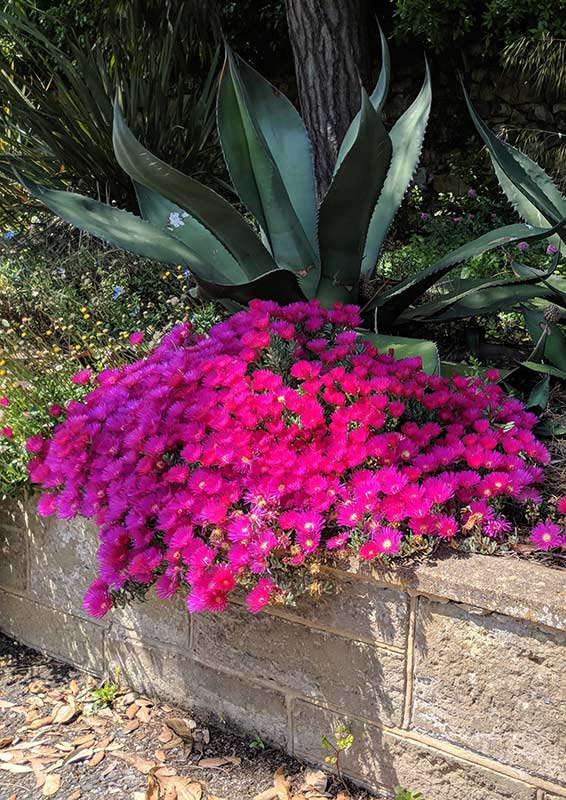
Lampranthus spectabilis 'Tresco Magenta' / syn. 'Tresco Brilliant' - Trailing ice plant
- half-tender succulent, perennial
- prostrate & spreading
- thick, three-angled to cylindrical leaves, dark grey-green foliage
- lark pink/magenta flower petals
- life span ~ 10 years
- use as rock plant or bedding plant, in a sheltered, sunny spot
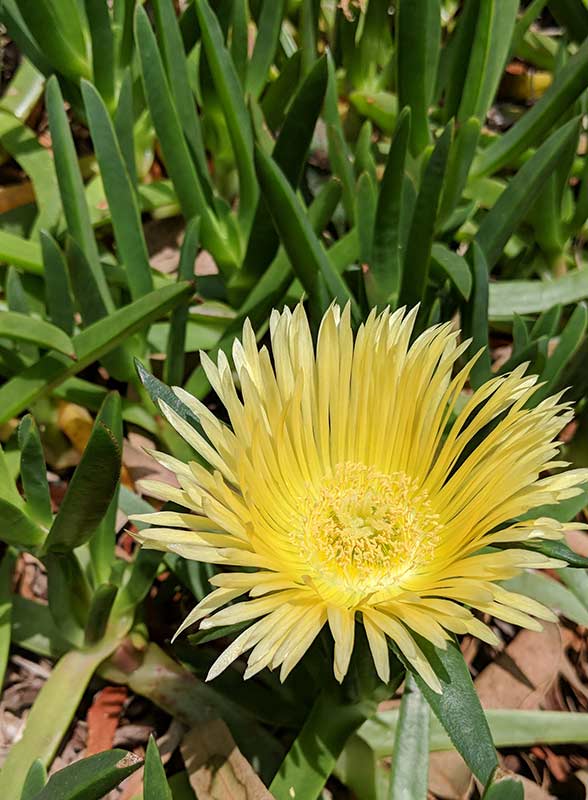
Lampranthus edulis / Carpobrotus edulis - Hottentot fig - Pig Face
- evergreen succulent, spreading
- large yellow or pink flowers (7-8.5 cm across)
- fleshy, curved leaves, triangular in cross section
- edible leaves
- grows in coastal areas rampant in Cornwall
- Very invasive, life span ~ 50 years
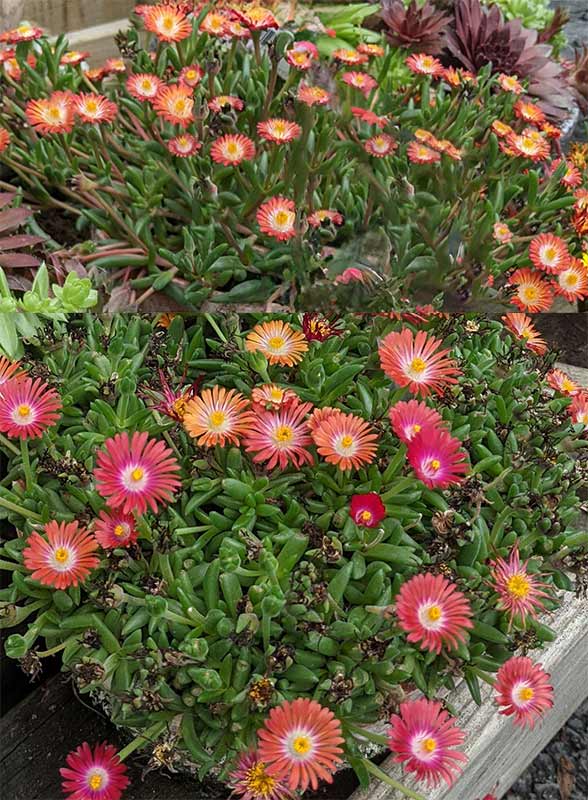
Delosperma - Suntropics spp. - various species and cultivars
- hardy, evergreen perennial
- collections in yellow, orange, pink, magenta, purple and white
- cylindrical light green leaves, up to 5cm long, and glossy
- heat, drought, salt tolerant
- good groundcover & in pots
- for naturalisation, borders, coastal gardens
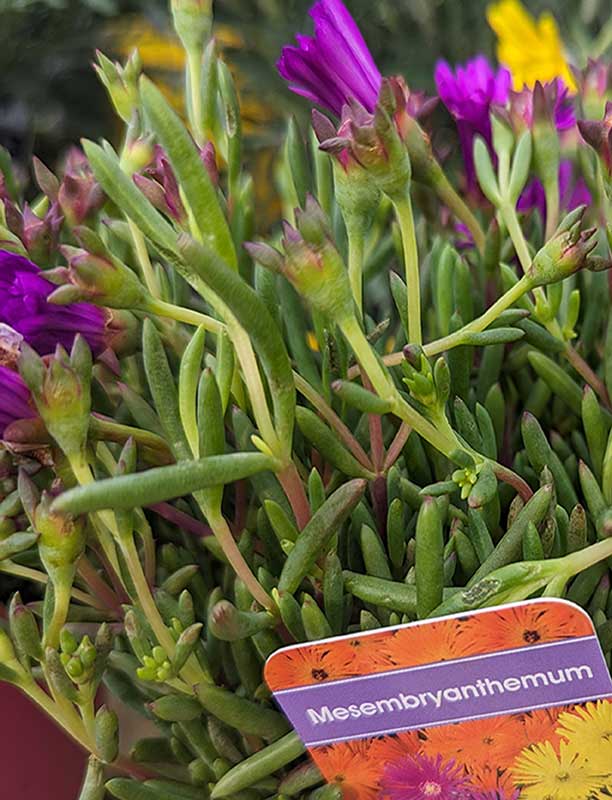
Mesembryanthemum / Livingstone Daisy
- tender perennial, needs to be taken in a greenhouse to overwinter or are treated as summer bedding plant
- drought-tolerant, low-growing succulent
- Great varieties are available already now.
- Can be easily grown from seed.
All images are subject to copyright of Pooleladygardener.co.uk.
Note:
Carpobrotus edulis, Delosperma spp. and Lampranthus spp. were listed as being species of the genus Mesembryanthemum spp. in the past and are still displayed as such in some sources. However, a few years ago they have been given their own genus. That is why they are listed as separate genera in this article.
